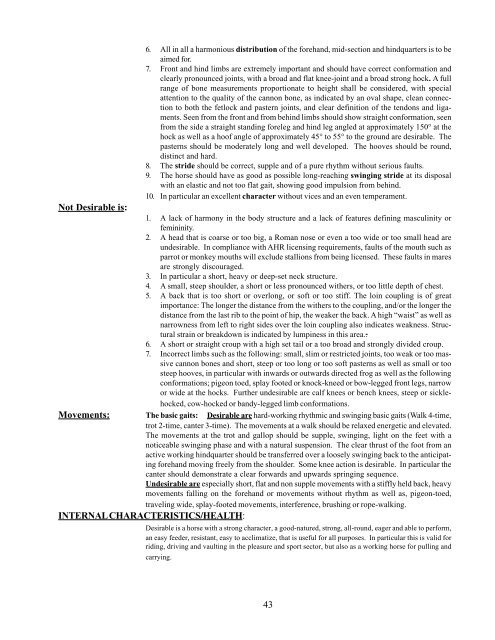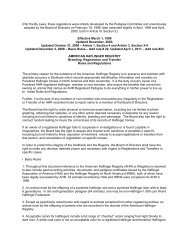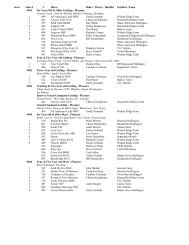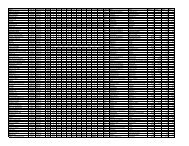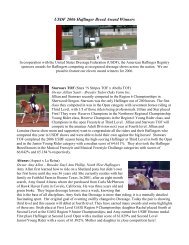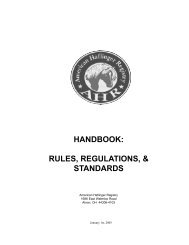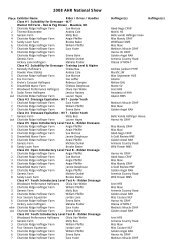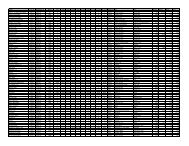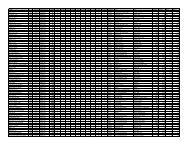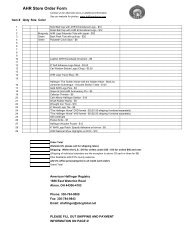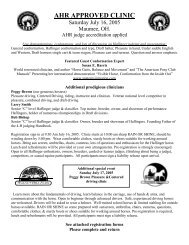handbook - American Haflinger Registry
handbook - American Haflinger Registry
handbook - American Haflinger Registry
You also want an ePaper? Increase the reach of your titles
YUMPU automatically turns print PDFs into web optimized ePapers that Google loves.
6. All in all a harmonious distribution of the forehand, mid-section and hindquarters is to beaimed for.7. Front and hind limbs are extremely important and should have correct conformation andclearly pronounced joints, with a broad and flat knee-joint and a broad strong hock. A fullrange of bone measurements proportionate to height shall be considered, with specialattention to the quality of the cannon bone, as indicated by an oval shape, clean connectionto both the fetlock and pastern joints, and clear definition of the tendons and ligaments.Seen from the front and from behind limbs should show straight conformation, seenfrom the side a straight standing foreleg and hind leg angled at approximately 150° at thehock as well as a hoof angle of approximately 45° to 55° to the ground are desirable. Thepasterns should be moderately long and well developed. The hooves should be round,distinct and hard.8. The stride should be correct, supple and of a pure rhythm without serious faults.9. The horse should have as good as possible long-reaching swinging stride at its disposalwith an elastic and not too flat gait, showing good impulsion from behind.10. In particular an excellent character without vices and an even temperament.Not Desirable is:1. A lack of harmony in the body structure and a lack of features defining masculinity orfemininity.2. A head that is coarse or too big, a Roman nose or even a too wide or too small head areundesirable. In compliance with AHR licensing requirements, faults of the mouth such asparrot or monkey mouths will exclude stallions from being licensed. These faults in maresare strongly discouraged.3. In particular a short, heavy or deep-set neck structure.4. A small, steep shoulder, a short or less pronounced withers, or too little depth of chest.5. A back that is too short or overlong, or soft or too stiff. The loin coupling is of greatimportance: The longer the distance from the withers to the coupling, and/or the longer thedistance from the last rib to the point of hip, the weaker the back. A high “waist” as well asnarrowness from left to right sides over the loin coupling also indicates weakness. Structuralstrain or breakdown is indicated by lumpiness in this area..6. A short or straight croup with a high set tail or a too broad and strongly divided croup.7. Incorrect limbs such as the following: small, slim or restricted joints, too weak or too massivecannon bones and short, steep or too long or too soft pasterns as well as small or toosteep hooves, in particular with inwards or outwards directed frog as well as the followingconformations; pigeon toed, splay footed or knock-kneed or bow-legged front legs, narrowor wide at the hocks. Further undesirable are calf knees or bench knees, steep or sicklehocked,cow-hocked or bandy-legged limb conformations.Movements: The basic gaits: Desirable are hard-working rhythmic and swinging basic gaits (Walk 4-time,trot 2-time, canter 3-time). The movements at a walk should be relaxed energetic and elevated.The movements at the trot and gallop should be supple, swinging, light on the feet with anoticeable swinging phase and with a natural suspension. The clear thrust of the foot from anactive working hindquarter should be transferred over a loosely swinging back to the anticipatingforehand moving freely from the shoulder. Some knee action is desirable. In particular thecanter should demonstrate a clear forwards and upwards springing sequence.Undesirable are especially short, flat and non supple movements with a stiffly held back, heavymovements falling on the forehand or movements without rhythm as well as, pigeon-toed,traveling wide, splay-footed movements, interference, brushing or rope-walking.INTERNAL CHARACTERISTICS/HEALTH:Desirable is a horse with a strong character, a good-natured, strong, all-round, eager and able to perform,an easy feeder, resistant, easy to acclimatize, that is useful for all purposes. In particular this is valid forriding, driving and vaulting in the pleasure and sport sector, but also as a working horse for pulling andcarrying.43


